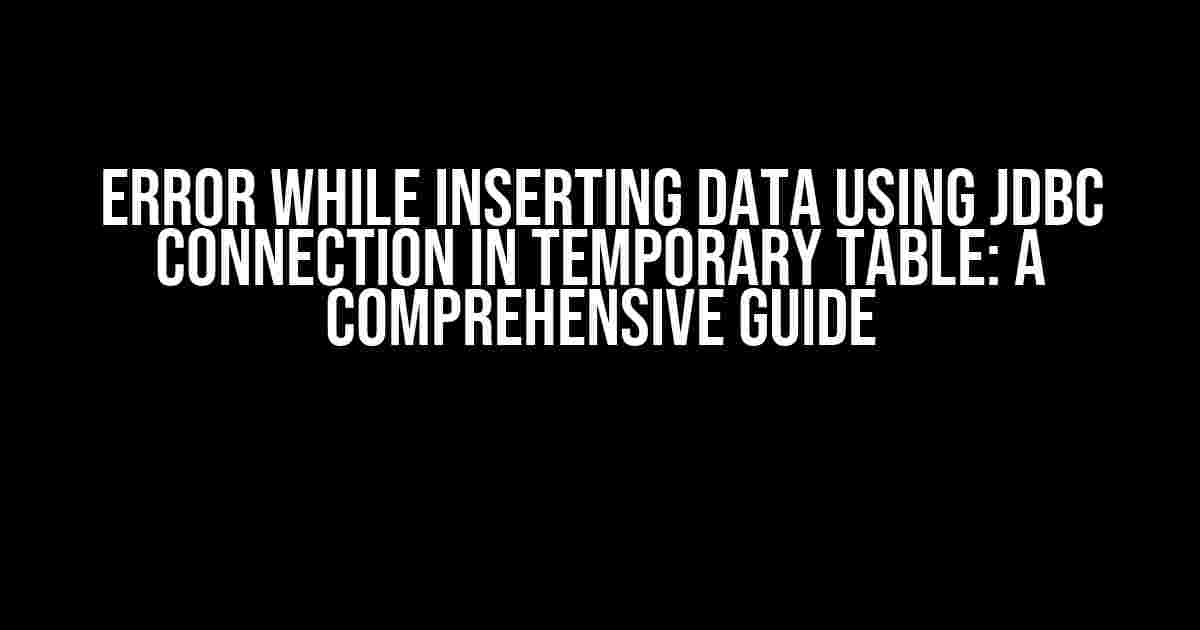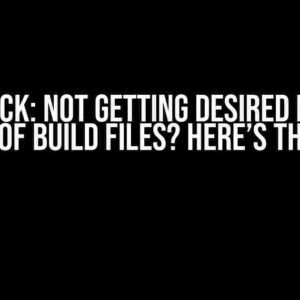Are you tired of struggling with errors while attempting to insert data into a temporary table using a JDBC connection? You’re not alone! Many developers face this issue, and it can be frustrating to troubleshoot. In this article, we’ll dive deep into the world of JDBC connections and temporary tables, exploring the common pitfalls and providing you with actionable solutions to overcome them.
What is a Temporary Table?
Before we dive into the error solutions, let’s quickly review what a temporary table is. A temporary table is a table that exists only for the duration of a session or transaction. It’s a transient storage area for data that you need to manipulate or process temporarily. Temporary tables are often used in scenarios where you need to perform complex data transformations, aggregations, or joins.
Benefits of Using Temporary Tables
Temporary tables offer several benefits, including:
- Faster data processing: Temporary tables can improve query performance by reducing the amount of data being processed.
- Improved data integrity: Temporary tables can help maintain data consistency by allowing you to validate and cleanse data before inserting it into a permanent table.
- Simplified data analysis: Temporary tables provide a convenient way to perform data analysis and visualization without affecting the underlying database.
The Error: Inserting Data into a Temporary Table using JDBC
Now that we’ve covered the basics of temporary tables, let’s focus on the error at hand. When attempting to insert data into a temporary table using a JDBC connection, you might encounter the following error message:
java.sql.SQLException: Error while inserting data into temporary table
at com.mysql.cj.jdbc.exceptions.SQLError.createSQLException(SQLError.java:686)
at com.mysql.cj.jdbc.exceptions.SQLError.createSQLException(SQLError.java:663)
at com.mysql.cj.jdbc.exceptions.SQLError.createSQLException(SQLError.java:653)
at com.mysql.cj.jdbc.PreparedStatement.executeInternal(PreparedStatement.java:1931)
at com.mysql.cj.jdbc.PreparedStatement.executeUpdate(PreparedStatement.java:2303)
at com.example.DataInsertion.insertData(DataInsertion.java:32)
at com.example.Main.main(Main.java:12)
This error can occur due to various reasons, including:
- Incorrect JDBC connection configuration
- Incompatible database driver version
- Invalid SQL syntax
- Temporary table already exists
- Insufficient database privileges
Solutions to the Error
Don’t worry; we’ve got you covered! Here are the step-by-step solutions to resolve the error:
Solution 1: Check JDBC Connection Configuration
Verify that your JDBC connection configuration is correct. Ensure that you’ve specified the correct database URL, username, and password. Also, make sure you’re using the correct JDBC driver version compatible with your database.
// Correct JDBC connection configuration String url = "jdbc:mysql://localhost:3306/mydatabase"; String username = "myuser"; String password = "mypass"; Connection conn = DriverManager.getConnection(url, username, password);
Solution 2: Ensure Compatible Database Driver Version
Confirm that you’re using the correct database driver version compatible with your database. You can check the database driver version using the following code:
// Get the database driver version
DatabaseMetaData metaData = conn.getMetaData();
String databaseProductName = metaData.getDatabaseProductName();
String databaseProductVersion = metaData.getDatabaseProductVersion();
System.out.println("Database Product Name: " + databaseProductName);
System.out.println("Database Product Version: " + databaseProductVersion);
Solution 3: Validate SQL Syntax
Review your SQL syntax to ensure it’s correct and compatible with your database. Check for any syntax errors, incorrect column names, or invalid data types.
// Correct SQL syntax String createTempTableQuery = "CREATE TEMPORARY TABLE temp_table (id INT, name VARCHAR(255))"; String insertDataQuery = "INSERT INTO temp_table (id, name) VALUES (?, ?)"; Statement stmt = conn.createStatement(); stmt.execute(createTempTableQuery); PreparedStatement pstmt = conn.prepareStatement(insertDataQuery); pstmt.setInt(1, 1); pstmt.setString(2, "John Doe"); pstmt.executeUpdate();
Solution 4: Drop Existing Temporary Table
If the temporary table already exists, you may encounter an error. To resolve this, simply drop the existing temporary table before creating a new one.
// Drop existing temporary table String dropTempTableQuery = "DROP TEMPORARY TABLE IF EXISTS temp_table"; Statement stmt = conn.createStatement(); stmt.execute(dropTempTableQuery);
Solution 5: Verify Database Privileges
Ensure that the database user account has sufficient privileges to create and insert data into the temporary table.
// Grant privileges to the database user String grantPrivilegesQuery = "GRANT CREATE, INSERT ON mydatabase.* TO 'myuser'@'%'"; Statement stmt = conn.createStatement(); stmt.execute(grantPrivilegesQuery);
Best Practices for Using Temporary Tables with JDBC
To avoid common pitfalls and ensure smooth data insertion, follow these best practices:
- Use a consistent naming convention for temporary tables.
- Avoid using permanent tables for temporary data storage.
- Drop temporary tables when no longer needed to avoid performance issues.
- Use parameterized queries to prevent SQL injection attacks.
- Test and validate your SQL syntax before executing it.
- Close JDBC connections and statements when finished to avoid resource leaks.
Conclusion
In conclusion, inserting data into a temporary table using a JDBC connection can be a breeze when you follow the correct procedures and troubleshoot common errors. By adhering to the solutions and best practices outlined in this article, you’ll be able to overcome the “Error while inserting data using JDBC connection in temporary table” issue and focus on developing robust and efficient applications.
Happy coding!
| JDBC Connection Configuration | Incompatible Database Driver Version | Invalid SQL Syntax | Temporary Table Already Exists | Insufficient Database Privileges |
|---|---|---|---|---|
| Incorrect URL, username, or password | Incompatible driver version with database | Syntax errors, incorrect column names, or invalid data types | Temporary table already created in the current session | Lack of CREATE, INSERT, or UPDATE privileges |
Remember, a well-crafted JDBC connection and temporary table strategy can make all the difference in your application’s performance and reliability. Stay tuned for more informative articles on JDBC and database-related topics!
Here are 5 Questions and Answers about “Error while inserting data using jdbc connection in temporary table” :
Frequently Asked Question
Having trouble inserting data into a temporary table using JDBC connection? Don’t sweat, we’ve got you covered!
Q: What’s the most common reason for an error while inserting data into a temporary table using JDBC connection?
A: The most common reason is that the temporary table doesn’t exist or is not properly defined. Make sure to create the temporary table before inserting data into it, and double-check the table name and structure.
Q: How do I troubleshoot the error when inserting data into a temporary table using JDBC connection?
A: To troubleshoot the error, check the JDBC connection logs for any errors or exceptions. Also, verify that the temporary table is created successfully and exists in the database. You can use tools like IntelliJ IDEA or Eclipse to debug the JDBC code and identify the issue.
Q: What’s the difference between a permanent table and a temporary table in JDBC connection?
A: A permanent table is a regular table that exists in the database until it’s explicitly dropped. A temporary table, on the other hand, is a table that exists only for the duration of the JDBC connection or session. Temporary tables are useful for storing intermediate results or data that needs to be processed temporarily.
Q: How do I create a temporary table using JDBC connection?
A: You can create a temporary table using the `CREATE TABLE` statement with the `TEMPORARY` keyword. For example, `CREATE TEMPORARY TABLE temp_table (id INT, name VARCHAR(50));`. This will create a temporary table that exists until the JDBC connection is closed.
Q: Can I use JDBC batching to insert data into a temporary table?
A: Yes, you can use JDBC batching to insert data into a temporary table. JDBC batching allows you to execute multiple SQL statements as a single unit of work, which can improve performance when inserting large amounts of data. Simply use the `addBatch()` method to add the insert statements to the batch, and then execute the batch using the `executeBatch()` method.




